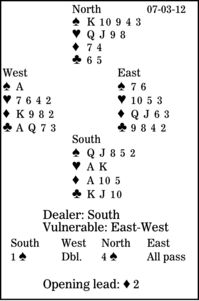Bridge column, July 3: The most important defensive rule

This column is going to concentrate on the most important defensive rule. A few years ago I was interviewed for a magazine. One question was: What technique do you teach your students that they never seem to get and you cannot understand why? This is it!
How can East and West defeat four spades after West leads a low diamond?
South opened one spade, and West made a textbook takeout double. Then North applied the Law of Total Tricks. Knowing that his side has at least 10 combined spades, North jumped to four spades, the 10-trick level. (However, if responder had 5-3-3-2 distribution, he should jump to only three spades.)
West's choice of opening lead is not obvious. There is a good case for the spade ace, West planning to sit back, hoping to take tricks with his four honor cards. But on this deal a diamond lead is needed.
When third hand plays the highest card so far contributed to the trick, he plays the bottom of his touchers. Here, East must play his jack. Then, when South wins with the ace, East is marked with the queen. So, when declarer leads a trump at trick two, West takes his ace and underleads his diamond king for a second time. East takes the trick with his queen and shifts to the club nine to give the defenders one spade, one diamond and two clubs.
Finally, if South ducks at trick one, East should immediately switch to a club.
** ** **
COPYRIGHT: 2012, UNITED FEATURE SYNDICATE
DISTRIBUTED BY UNIVERSAL UCLICK FOR UFS

